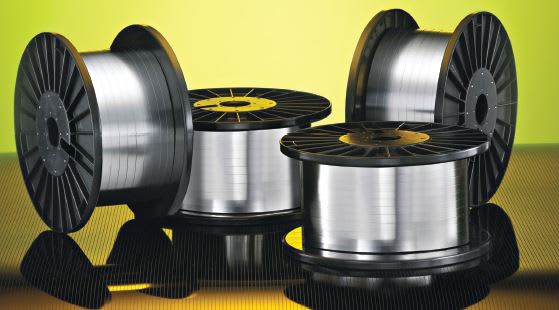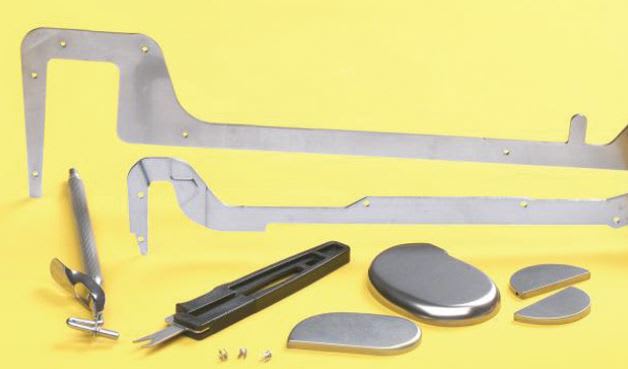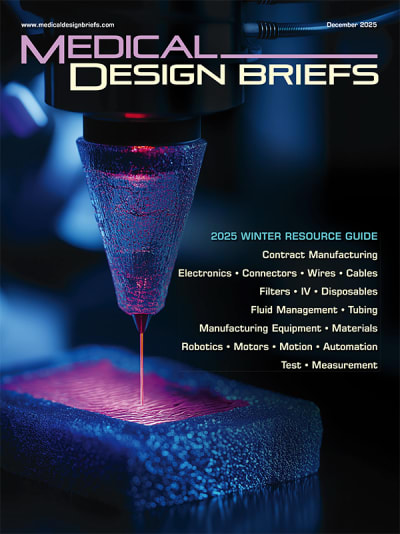Around the world, people are living longer, more active lives thanks to continuing advancements in medical technology. This evolution in technology stems from the development of metals and alloys that are finding new uses in internal and external medical applications. From improvements in diagnostic guide wires to new alloys for permanent implants in the body, metals continue to find new uses.
Wide Variety of Metals and Uses

The metals industry has a long history of innovation, development, and processing of metals and alloys, in step with medical device development. This has allowed development of new devices ranging from tiny screws for the smallest implants to complex surgical tools operated robotically. For decades, Stainless steel has been the volume champion of the medical device market. Ranging from 400 series for reusable surgical devices to 316LVM for implant purposes, stainless steel remains the go-to alloy of choice for most design engineers. Chief among these alloys is 304. SS304 is regarded the world over as one of the most suitable materials for the manufacture of medical devices and comes in many forms and finishes. From ultra-fine wire for catheter reinforcement to ultrawide strip material, 304 is used in devices ranging from angioplasty balloons to needle cannula to deep drawn component parts. The combination of good corrosion resistance and low cost make this alloy the reigning champion of the device industry.
Titanium is one of the most versatile metals used in internal applications. It resists corrosion and connects to human bone when properly treated, with fewer negative reactions than other metals. Osseointegration is a unique phenomenon where the body’s natural bone and tissue bond to the titanium implant, which firmly anchors the implant in place. Titanium is also now a staple in the medical field for uses such as shields for implanted devices that control heart function; products that dispense medicine and perform various neurostimulation; and orthopedic rods, pins, and plates.
Pure titanium has low density, high strength, and high corrosion resistance and is also a good candidate material when processing or forming into subassemblies or finished components. It is considered to be physiologically inert. Titanium alloys Ti-6Al-4V and Ti-6Al-4V ELI are especially nonreactive with fluids in the human body and are commonly used in medical devices due to the low risk of rejection.
Some of the most common uses for titanium are in orthopedic surgery; hip, knee, spinal, facial, and shoulder and elbow joint replacements are among the multiple uses for this material. Some forms of replacement heart valves use titanium housings or material support rings. Titanium pegs are used to attach prosthetic eyes and ears as a result of recent medical advances. Titanium is a standard shield material in such implanted medical devices as pacemaker and defibulator cases due to its resistance to attack by body fluids, high strength, and low modulus.
In addition to its use inside the body, titanium is an ideal choice for surgical instruments, such as drills, forceps, retractors, scissors, needle holders, and Lasik eyesurgery equipment. The metal is also compatible with MRIs or CT scans.

Niobium: There is growing interest in niobium and its alloys for use in medical devices. It is often found in devices such as pacemakers because the metal is physiologically inert. Niobium treated with sodium hydroxide forms a porous layer that aids osseointegration, which also makes it an attractive alternative for internal medical applications. Type 1 niobium consists of pure niobium, which is reactor grade, with a high melting point and is corrosion resistant. It also is used in high-temperature industrial applications. Type 2 niobium is a commercial- grade alloy with an extremely high melting point and corrosion-resistant properties. It has a higher residual tantalum content and, like type 1, it has high thermal and electric conductivity, is easily fabricated, and is biocompatible.
Tantalum is another increasingly popular metal that has been used in medical devices as simple as diagnostic marker bands and as a catheter plastic compounding additive for more than 40 years. Tantalum is especially useful in shaped-wire applications due to its high ductility and its corrosion resistance, which makes it attractive for implants. Tantalum can be easily welded and exhibits good dielectric properties.
Nitinol is a nickel-titanium (about 51% Ni) shape memory alloy with superelastic properties—a reversible response to an applied stress. Shape memory refers to Nitinol’s ability to undergo deformation at one temperature, and then recover its original shape upon heating above its transformation temperature. Nitinol’s extraordinary ability to accommodate large strains, coupled with its physiological and chemical compatibility with the human body have made it an often sought after material in medical device engineering and design. Nitinol devices, such as stents, can be fabricated at one temperature, deformed or folded smaller at another temperature, then inserted into an artery where the body heats the material above its transformation temperature and it returns to its original size. Thus, a stent can be inserted when small and expand after insertion, opening up the artery or other vessel where it was placed. Its superelastic effect allows the use of Nitinol devices that have been bent or shaped to allow introduction or use inside the body. Tools, such as small grasping and biopsy devices, can extend from a tube and expand to a much larger area than devices made from standard alloys.
Nitinol’s light weight and unique properties make it especially attractive for use in biomedical applications including heart valve tools, staples, bone anchors, sophisticated septal defect devices, and a variety of implants. Other uses include diagnostic guide wires and repositionable wire markers to locate breast tumors for less invasive lumpectomy procedures in treating breast cancer.

Copper: Recently, the medical industry has focused research dollars into copper and its alloys. Previously off limits for most medical purposes due to its thrombogenic risks, copper has found new interest in the device community. At the heart of this interest is the fact that properly shielded copper can be effectively used to carry signals to small implants and diagnostic tools. Leading manufacturers and processors of copper for medical devices typically produce the shielded metal wire or strips on their own dedicated equipment to maintain 100% quality control and avoid cross-contamination. Due to its high conductivity, it is possible to embed smaller copper wires into devices to take the place of larger or more expensive materials to send and receive signals or carry electrical charges to accomplish tasks inside the body.
Copper is also being researched as an anti-microbial surface for use in hospital and clinical settings to try and reduce acquired infections. In the United States, 4.5% of hospitalized patients develop healthcare-associated infections (HAIs) annually, resulting in an estimated 100,000 deaths and adding $35.7 to $45 billion dollars to healthcare costs, according to the report “Healthcare- Associated Infections,” posted on the Internet, March 25, 2013, by the Centers for Disease Control and Prevention.
In a study conducted for the U.S. Department of Defense, “Copper Surfaces Reduce the Rate of Healthcare- Acquired Infections in the Intensive Care Unit,” published in Infection Control and Hospital Epidemiology, patients cared for in intensive care unit rooms with copper alloy surfaces had a significantly lower rate of incident HAIs and/or colonization with such bacterial infections as methicillin-resistant Staphylococcus Aureus or vancomycin-resistant enterococci than did patients treated in standard rooms. Studies directed by the United States Environ mental Protection Agency, resulted in the 2008 registration of 274 different copper alloys as certified antimicrobial materials that have public health benefits.
Conclusion
Successful applications of the above metals result from metals manufacturers working closely with device manufacturers. Starting with the desired design and materials specifications, raw material suppliers follow through the design cycle to completion of a device. Proper and timely communication between supplier and end user allows a seamless transition from prototype to final finished device.
This article was written by Todd Hall, Medical Product Manager, Ulbrich Stainless Steels & Special Metals, Inc., North Haven, CT. For more information, Click Here .



